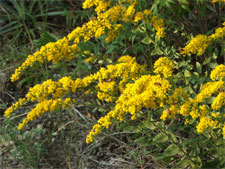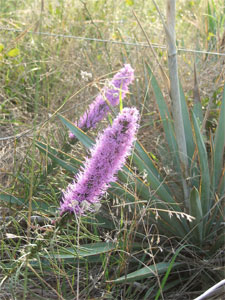Native Son – September, 2008

A quintessential Texas country scene with false gaura (Stenosiphon linifolius) in the foreground. Photo by Steven Chamblee.
Quintessential Texas
Goldenrod and Gayfeather
A few hours ago, I was slowly puttering down Old Garner Road, reminding myself this is the reason that I moved out here. This is quintessential Texas: sprawling cattle and horse ranches, curvy little roads that dive down occasionally to cross a "crick," sunsets that light up meadows with a miraculous glow, and my favorite, the natural ebb and flow of wildflowers as you pass.
Nothing too out of the ordinary in bloom for late summer, but I was pleased to see how long the list got in just a few miles: prairie onion, winterfat, azure sage, eryngo, gaillardia, bull nettle, LOTS of sunflowers and false gaura (summer whiterocket!). The Indiangrass soared high, the flame-leaf sumac had begun showing glowing embers, and the innocent-looking swollen flower buds on giant ragweed belied the sinus torture that is about to begin. Yep, there is some goldenrod in bloom not far away … a sure sign that, once again, folks will blame the flamboyant goldenrod flowers for their allergy woes.

Willow goldenrod (Solidago ludoviciana). Photo by the author.
Fact is that goldenrod pollen forms in clumps called "pollenia," which are too heavy to be carried by the wind, so they don’t give you the allergic reaction. (I know…. "But I start sneezing every time I see goldenrod, so don’t give me that bunk!" Read on.) The other half of the story is that gazillions of giant ragweed (Ambrosia trifida var. texana) plants shed literally tons of light, wind-carried pollen into the air at the same time that goldenrod is in bloom. We see and suspect the goldenrod because it is brightly colored, but the real culprit is the "medium-green-flowered, fade-into-the-background" giant ragweed. (And to be sure, there are other species of ragweed at work here as well.) Ahhh, the plight of the falsely accused … surely there is a one-armed man behind all of this.
Goldenrod serves a real purpose, of course, just like all wildflowers. It sets a banquet table for the parade of fall butterflies, most notably the Monarch. There are many different goldenrod species in North Central Texas, enhancing both the range of ecosystems where it will grow and the length of flowering time (roughly late August to mid-November). I noticed several species on my drive, and believe the photo to show willow goldenrod (Solidago ludoviciana).

Narrow-leaf gayfeather (Liatris mucronata). Photo by the author.
A few yards away, another great fall bloomer is putting on the Ritz — gayfeather, also known as blazingstar. These little beauties arise from underground bulbs (technically, corms) into 1- to 3-foot-tall, thin-leaved spikes accented with a densely flowered, fuzzy purple tip. They also provide high-quality nectar for butterflies, and a range of species enhances their span of bloom time. Narrow-leaf gayfeather (Liatris mucronata) seems to be the dominant species out here in Parker County.
In case this hasn’t slid into your subconscious via the back alley and come around to smack you in the forehead by now, these two native Texas beauties are superb partners in the garden. The concurrent bloom time, dramatic color contrast, and ease of cultivation, combined with their ability to draw hoards of butterflies to your garden, make them a definitive dynamic duo.
A friend of mine recently mentioned how amazed he was at my incredible intelligence and horticultural savvy. Not being smart enough to just take the compliment and run, I quizzed him until he said something about "knowing everything about all these native plants, both common and obscure." Well folks, I am smart enough to own and use what I call "The BRIT Book." (BRIT is the Botanical Research Institute of Texas, based in Fort Worth.) Technically known as Shinners & Mahler’s Illustrated Flora of North Central Texas, this 1600-page beauty is my (and I dare say the) primary reference for all things native around this part of the country. Basically, it is a book about North Central Texas plants that represents, I estimate, several hundred years of serious botanical work. This opus was started by Lloyd Shinners, built upon by Bill Mahler, then beefed up, expanded, updated, and made user-friendly by those brainy boys at BRIT: George Diggs, Barney Lipscomb, and Bob O’Kennon.
For those people proud enough to call themselves "plant fanatics," this is a must for your shelf. For those who know just one of those people … makes a perfect gift. Check out www.brit.org for more info.
About the author: Steven Chamblee is the chief horticulturist for Chandor Gardens in Weatherford and a regular contributor to Neil Sperry’s GARDENS magazine and e-gardens newsletter.
An invitation from Steven: Come see Chandor Gardens this fall! The new Labyrinth is completed and ready for you to enjoy. We’re even having a Scarecrow Contest just for fun. Oct. 25 to Nov. 16, we’ll have a great collection of scarecrows around the garden. This is a perfect time for family and children’s photos, so plan on bringing the whole gang out to Chandor Gardens.
Just take I-20 west from Fort Worth to exit 409, hang a right, go 2.1 miles and hang a left on Lee Avenue. Head straight 12 blocks, and you’re driving in the gates.
Our "for sure" open hours are Saturdays from 9 a.m. to 3 p.m. and Sundays from 1 p.m. to 5 p.m. For weekdays visits, give us a call at 817-361-1700 or 817-598-4029 to let us know you’re coming. You can always go to www.chandorgardens.com for a picture tour and more information.

